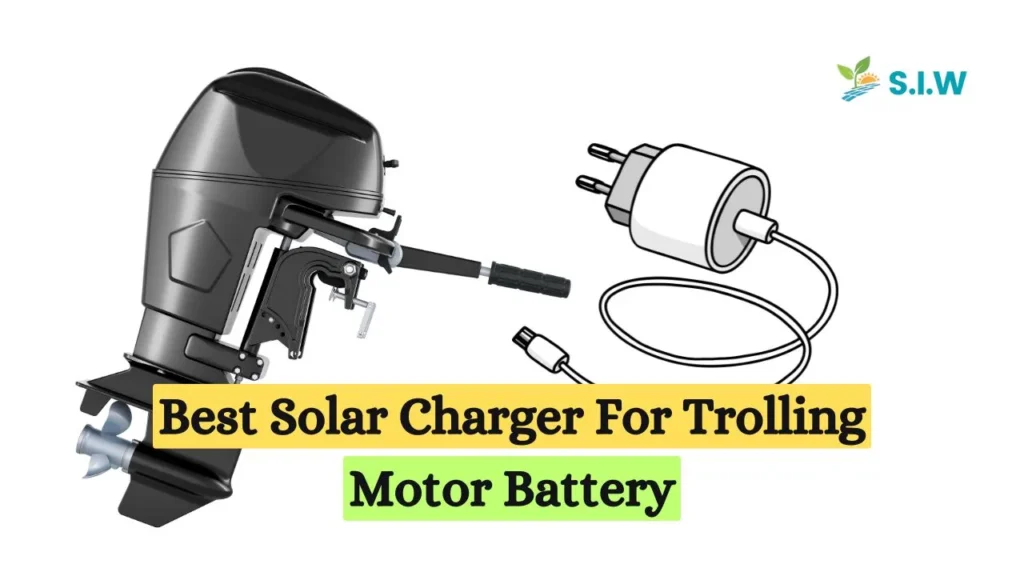A solar charger is a device that harnesses the power of the sun to charge your trolling motor battery. It uses photovoltaic cells to convert sunlight into electricity, which is then used to keep your battery topped up. Imagine it as a solar-powered assistant that ensures your motor is always ready to go, without needing to plug into a wall outlet.
Why Use a Solar Charger?
Using a solar charger has multiple advantages:
- Eco-Friendly: Solar power is a renewable resource, making it an environmentally friendly choice.
- Convenience: No need to find an electrical outlet or carry extra chargers.
- Cost-Effective: While the initial investment might be higher, it can minimize your energy bills in the long run and save you money.
Think of it as a way to tap into nature’s energy while you’re out enjoying it!
Key Features to Look For
When choosing a solar charger, consider the following features:
- Wattage: Higher wattage means faster charging. Look for a charger that matches or exceeds your battery’s requirements.
- Durability: It should withstand outdoor conditions, including water exposure and rough handling.
- Portability: If you’re frequently on the move, a lightweight and compact model is ideal.
- Compatibility: Ensure it’s compatible with your battery type and trolling motor.
Top Solar Chargers for Trolling Motor Batteries
Here are some top picks that consistently receive high ratings:
- Renogy 100W Solar Panel Kit
- Features: High efficiency, durable, and comes with a charge controller.
- Pros: Reliable and efficient.
- Cons: May be bulky for small boats.
- ALLPOWERS 18V 12V 10W Portable Solar Panel
- Features: Compact, lightweight, and flexible.
- Pros: Easy to carry and store.
- Cons: Lower wattage, might charge slower.
- BougeRV 100W Solar Panel
- Features: High efficiency, weather-resistant.
- Pros: Great for various weather conditions.
- Cons: Requires additional accessories for optimal performance.
How to Install a Solar Charger
- Choose a Location: Install the solar panel where it will receive maximum sunlight. This could be on the boat’s deck or another flat surface.
- Mount the Panel: Use the provided brackets or adhesive to secure the panel.
- Connect the Charger: Hook up the solar panel to your solar charged trolling motor battery using the appropriate cables and connectors.
Maintaining Your Solar Charger
Regular maintenance is essential to keep your solar charger in top shape:
- Clean the Panel: Wipe it down with a soft cloth to remove dirt and debris.
- Check Connections: Ensure all connections are secure and free of corrosion.
- Inspect for Damage: Regularly check the panel for any signs of wear and tear.
Comparing Solar Chargers
When comparing solar chargers, consider:
- Efficiency: How quickly does the charger replenish your battery?
- Build Quality: Is it sturdy enough for your needs?
- Cost: Does the price match the features and performance?
Budget vs. Quality
While cheaper options might seem appealing, investing in a higher-quality solar charger can offer better performance and durability. Remember, a well-made solar charger can save you time and money in the long run.
Tips for Maximizing Efficiency
- Positioning: Place the panel at the optimal angle for sunlight.
- Cleaning: Keep the panel clean to ensure maximum light absorption.
- Avoid Shadows: Ensure there are no obstructions casting shadows on the panel.
Portable vs. Fixed Solar Panels
- Portable Panels: Easy to move and adjust; ideal for varying sunlight conditions.
- Fixed Panels: More permanent solution; great for consistent, long-term use.
Real User Reviews
Reading user reviews can provide insights into how a solar charger performs in real-world conditions. Look for feedback on reliability, ease of use, and customer service.
Environmental Impact
Solar chargers are a sustainable choice that reduces your reliance on fossil fuels. They help minimize your environmental footprint, making them a great option for eco-conscious individuals.
Troubleshooting Common Issues
- Not Charging: Check connections and ensure the panel is receiving sunlight.
- Slow Charging: Verify the wattage and position of the panel.
- Panel Damage: Inspect for cracks or other damage that may affect performance.
The Future of Solar Charging Technology
Solar charging technology is continually advancing, with improvements in efficiency and durability. Keep an eye out for new innovations that could further enhance your solar charging experience.
Choosing the best solar charger for your trolling motor battery can enhance your boating experience by ensuring you always have power when you need it. By considering factors such as wattage, durability, and portability, you can find a solar charger that fits your needs and budget. With the right solar charger, you’ll enjoy more time on the water and less worry about battery life.
FAQs
- What wattage solar charger do I need for my trolling motor battery?
It depends on your battery’s capacity and your usage. Generally, a 100W panel is a good starting point. - Can I use a solar charger in cloudy conditions?
Yes, but the charging efficiency will be reduced. It’s best to place your panel where it can get the most sunlight. - How long does it take to charge a trolling motor battery with a solar charger?
Charging time varies based on the panel’s wattage and the battery’s size. Check the manufacturer’s guidelines for specific times. - Are portable solar chargers as effective as fixed panels?
Portable chargers are effective but might have lower wattage. Fixed panels generally offer more consistent performance. - How do I maintain my solar charger?
Keep it clean, check connections regularly, and inspect for any damage to ensure optimal performance.








